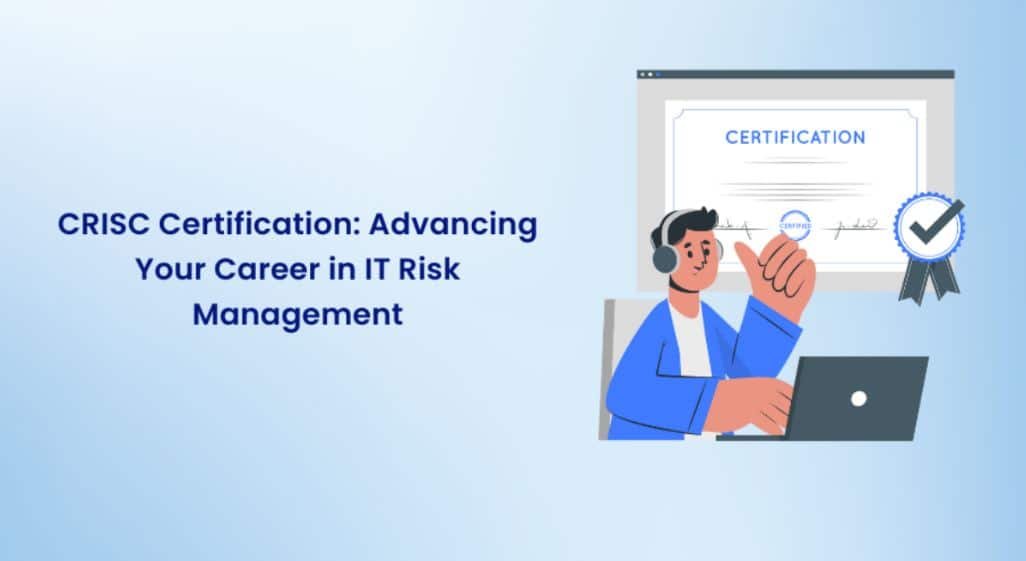Education
CRISC Certification: Advancing Your Career in IT Risk Management

In today’s interconnected world, organisations face an increasing number of risks related to information technology (IT). To effectively manage these risks, professionals need a comprehensive understanding of IT risk management principles and practices. This is where the Certified in Risk and Information Systems Control (CRISC) certification comes into play. Designed by ISACA, the CRISC Certification equips individuals with the knowledge and skills required to identify, assess, and mitigate IT risks. In this blog, we will explore What is CRISC, the significance of CRISC certification, its benefits, and the steps to become a Certified Risk and Information Systems Control professional.
Understand What is CRISC
The initials CRISC stand for Certified in Risk and Information Systems Control. It is a globally recognized certification designed for professionals in the field of IT risk management. Offered by ISACA (Information Systems Audit and Control Association), the CRISC certification validates an individual’s knowledge, skills, and expertise in identifying, assessing, and managing IT risks within an organization. The CRISC certification focuses on the areas of IT risk identification, assessment, response, and monitoring. It equips professionals with the necessary tools and techniques to establish effective risk management strategies and align them with business objectives. By obtaining the CRISC certification, individuals demonstrate their ability to navigate the complex landscape of IT risks, ensure compliance with regulatory requirements, and safeguard valuable information assets.
The Importance of CRISC Certification
As technology continues to play a critical role in business operations, organisations must prioritise IT risk management to protect their assets, ensure regulatory compliance, and maintain business continuity. The CRISC certification demonstrates a professional’s ability to understand and manage IT risks effectively, making them invaluable assets to organisations.
CRISC certification provides professionals with a holistic approach to IT risk management, covering areas such as risk identification, assessment, response, and monitoring. It equips them with the necessary skills to align IT risk management practices with business objectives, enabling informed decision-making and strategic planning.
With the rise in cybersecurity threats, data breaches, and regulatory requirements, employers value professionals who can navigate the complex landscape of IT risk. CRISC-certified individuals bring credibility and expertise to the table, ensuring organisations can confidently mitigate IT risks and protect their valuable assets.
Benefits of CRISC Certification
Acquiring the CRISC certification offers several benefits for professionals seeking to advance their careers in IT risk management:
- Enhanced Career Opportunities: CRISC certification distinguishes professionals from their peers, opening doors to a wide range of career opportunities in IT risk management, including roles such as IT risk analysts, IT auditors, compliance officers, and security managers. Employers actively seek CRISC-certified professionals due to their specialised knowledge and skills.
- Industry Recognition: CRISC is globally recognised and respected in the field of IT risk management. Holding this certification demonstrates your commitment to professional development and adherence to industry best practices. It establishes your credibility and differentiates you from non-certified professionals.
- Increased Earning Potential: CRISC-certified professionals often enjoy higher earning potential compared to their non-certified counterparts. Employers value the expertise and specialised skill set that comes with CRISC certification, resulting in better compensation packages.
- Expanded Knowledge and Skills: The CRISC certification provides comprehensive knowledge in IT risk management domains, such as IT risk identification, assessment, response, and monitoring. It equips professionals with the necessary tools and techniques to analyse complex IT risks and implement effective risk mitigation strategies.
- Networking Opportunities: Becoming CRISC-certified connects you with a global community of IT risk management professionals. Engaging with this network through conferences, events, and online platforms allows you to exchange ideas, gain insights, and build valuable professional relationships.
Steps to Becoming a Certified in Risk and Information Systems Control (CRISC) Professional
To become CRISC-certified, professionals need to follow a structured process:
- Meet the Eligibility Requirements: Candidates must have at least three years of cumulative work experience in at least three of the four domains covered by the CRISC certification. These domains include IT risk identification, assessment, response, and monitoring.
- Study and Preparation: CRISC certification requires a deep understanding of IT risk management concepts, frameworks, and practices. Utilise official study materials, review guides, and practice exams provided by ISACA. Consider enrolling in training courses or workshops to supplement your knowledge.
- Register for the Exam: Once adequately prepared, register for the CRISC exam through the ISACA website. Each year, there are three testing windows for the computer-based exam. Familiarise yourself with the exam format, duration, and the weightage of each domain.
- Exam Preparation: Create a study plan that covers all domains and allocates sufficient time for review and practice. Utilise practice exams to familiarise yourself with the question style, manage time effectively, and identify areas that require further attention.
- Take the Exam: On the scheduled date, take the CRISC exam at an authorised testing centre. The exam consists of 150 multiple-choice questions that must be completed within four hours. Achieving a passing score is required to earn the certification.
- Maintain the Certification: CRISC certification is valid for three years. To maintain your certification, you must earn Continuing Professional Education (CPE) credits each year and adhere to the ISACA Code of Professional Ethics and Continuing Professional Education Policy.
Conclusion
The CRISC certification equips professionals with the knowledge and skills necessary to identify, assess, and mitigate IT risks effectively. By obtaining this certification, individuals gain a competitive edge in the IT risk management field, opening doors to exciting career opportunities and increasing their earning potential. The CRISC certification also provides industry recognition, validating a professional’s expertise and commitment to the highest standards of IT risk management. To become a CRISC professional, aspiring candidates should meet the eligibility requirements, thoroughly prepare for the exam, and demonstrate their understanding of IT risk management concepts. By following the steps outlined in this blog and investing in continuous professional development, individuals can embark on a rewarding journey towards a successful career in IT risk management.
-

 Entertainment2 months ago
Entertainment2 months agoBflix.gg Not Working? Here’s Where You Can Stream Free Now
-

 Fashion2 months ago
Fashion2 months agoVintage Styles Making a Comeback: Trends You Should Know
-

 Tech1 month ago
Tech1 month agoLatest Durostech Updates: Key Highlights
-

 Entertainment2 months ago
Entertainment2 months agoIs Shannon Reardon the Same as Swanick? Here’s What We Know






